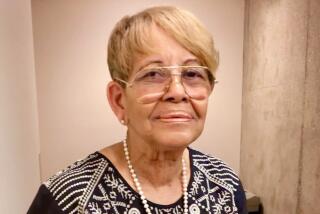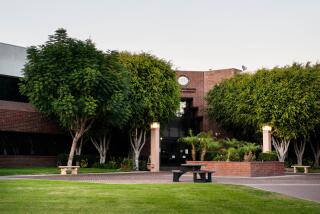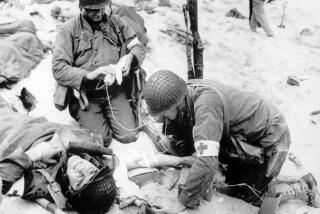Dr. King Legacy Lives On at Drew Medical School
Kimberly Gregory was a 9-year-old coming home from grade school in Carson on April 4, 1968, when she walked into her family’s residence. She found the normally bright living room darkened and her mother watching television, quietly crying.
Kimberly wasn’t old enough to understand the import of what her mother was weeping about, she recalls, but today, as a young black woman about to graduate from medical school, she understands it fully. Dr. Martin Luther King Jr. had been assassinated by a lone white gunman.
Riot in Chicago On that same day, at that same time, Stephen Keith was 16, the son of Dr. Laurel E. Keith, a prominent black Chicago physician living in one of that city’s vast black neighborhoods. Steve Keith completely understood the news.
Over the next few days, young Steve Keith watched as his community exploded in a bloody, fiery riot.
The boy’s father and King had met in Boston when Laurel Keith was attending Harvard Medical School and King was at Boston University from 1951 to 1953 on a fellowship that led to his doctorate in systematic theology.
A high point of Steve Keith’s life--now Dr. Stephen Keith--had come two years before. King, visiting Chicago for one of the city’s series of civil rights demonstrations during that era, sought brief respite from the tensions of his mission and stopped by the Keith house to sit and make small talk with the Keiths, recalling friends and good times in Boston years before.
Steve Keith was awed by the man who sat casually with his parents, chatting and exchanging news of their respective families. “It was,” recalled Keith one day last week, “one of the biggest things that ever happened in my life.”
Years passed and Kimberly Gregory and Steve Keith found themselves at the same place--she as a fourth-year student at Charles R. Drew Medical School on the southern periphery of Watts, and Keith as the school’s dean for student affairs. Gregory is about to become one of the first graduates of Drew’s undergraduate program--a still controversial experiment aimed at trying to increase the supply of doctors committed to fill the unmet primary health needs of the poor.
What would have been Martin Luther King Jr.’s 56th birthday will pass today without specific observation at Drew--whose first building opened last October on a plot of land directly across the street from Martin Luther King Jr. General Hospital. The hospital held a memorial service Saturday.
The Drew program’s administrators hope that by carefully screening medical school applicants (the student body is integrated, but with a heavy minority group representation), they can select those prospective doctors most likely to devote their lives to working with the poor and immerse them in a medical education program built around King Hospital and its patients.
Focus on Patient Care Prospective doctors who want to devote their lives to research are advised to apply elsewhere, Keith said, because Drew’s program is geared toward producing doctors who will work almost exclusively providing patient care in one of the primary care specialties--fields such as internal medicine, family practice, pediatrics and obstetrics and gynecology.
For Keith and Gregory, King’s memory is very much alive nonetheless and permeates the program at Charles Drew Medical School, they both agree.
King himself never knew that a hospital would be named after him. The hospital that would be called King was built as a result of the bloody riots that shook Watts in 1965. But as it was originally planned, the hospital was to be called South East General.
The ground breaking was to be April 10, 1968, six days after King was killed. And, because the change seemed so appropriate, the name was altered officially just before the first shovels of earth were turned. The medical school that now has such a close affiliation with King Hospital is named after a black Washington, D.C., physician who is one of the major pioneers of blood banking. Drew was killed in an auto crash in 1948.
After years of controversy over whether still another medical school was needed in Southern California--which already had five such institutions--Drew accepted its first students in 1980. Though the school focuses much of its attention on the needs of blacks, specifically--and the largest proportion of its students are black--it also includes white, Latino, Asian and American Indian students.
The first graduating class will include 16 students. Currently, incoming classes number about 24, a little less than half of whom are black.
Basics at UCLA Drew students trek to UCLA for their first two years of instruction--a period in medical school that focuses on basic science education. Eventually, Drew hopes to develop its own basic science program--perhaps as early as the end of this decade. For their final two years, Drew students return to the campus in South-Central Los Angeles to complete their practical training in a unique program that concentrates on basic care for about 200 King clinic patients.
Gregory, a young woman with a quiet manner and a quick sense of humor, hopes eventually to complete residency training in obstetrics and gynecology. She hopes to be accepted for her internship at a hospital in the Boston area--primarily because she recently became engaged and her fiance will be starting a residency in opthalmology there this summer.
Career Goal Eventually, Gregory said, she hopes to complete her training and sign up for a fellowship that will pave the way for her return to Los Angeles. Her goal: to practice in South-Central Los Angeles and teach full time at King and Drew.
She will always think of herself as a black physician and not simply a doctor who happens to be black, because, she said, “when you grow up, being black is simply a state of being. Whatever you are, it stays with you.”
Keith recognizes that King probably never knew there was even a plan for the Drew school. But he believes that the man with whom his parents were once so close would have approved of the idea behind Drew.
“We are a place that emphasizes patient care,” Keith said. “We want our doctors to see their patients as individuals, not bags of disease.”
More to Read
Sign up for Essential California
The most important California stories and recommendations in your inbox every morning.
You may occasionally receive promotional content from the Los Angeles Times.










